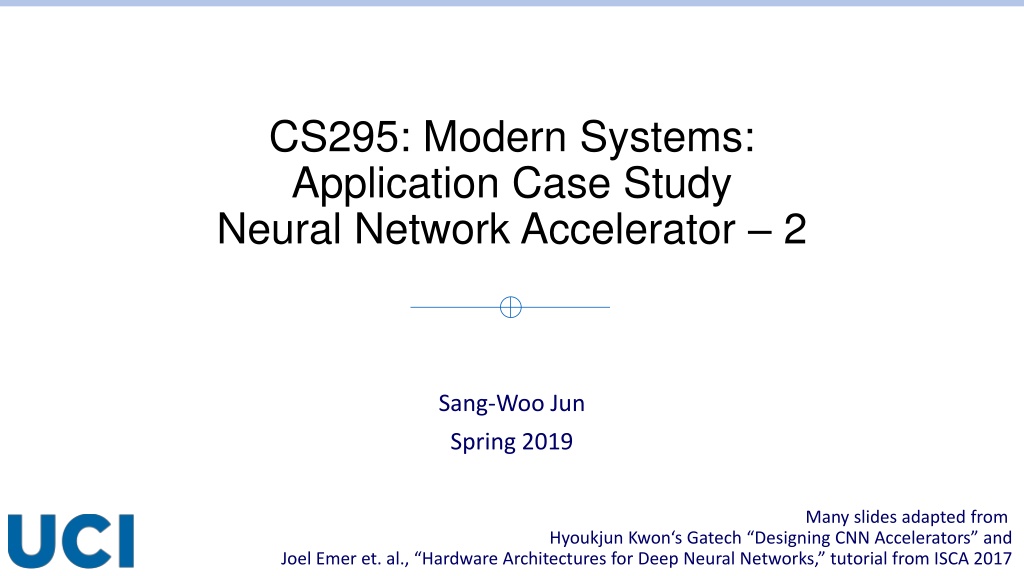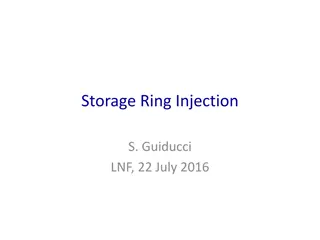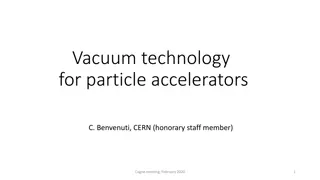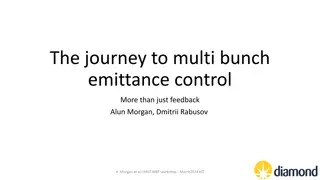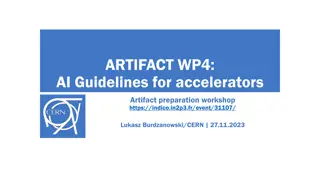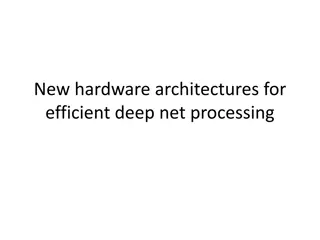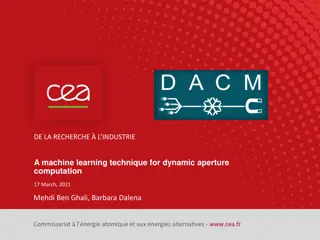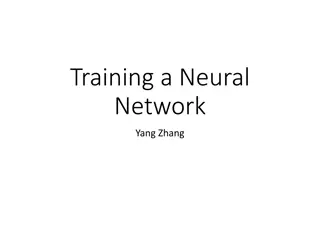Understanding the Need for Neural Network Accelerators in Modern Systems
Neural network accelerators are essential due to the computational demands of models like VGG-16, emphasizing the significance of convolution and fully connected layers. Spatial mapping of compute units highlights peak throughput, with memory access often becoming the bottleneck. Addressing over 300 billion weight/activation accesses for 100 GOPS and the challenges CPUs face in achieving such performance, this field requires innovative solutions to overcome memory limitations.
- Neural Network Accelerators
- Computational Demands
- Convolution Layers
- Fully Connected Layers
- Memory Bottleneck
Download Presentation

Please find below an Image/Link to download the presentation.
The content on the website is provided AS IS for your information and personal use only. It may not be sold, licensed, or shared on other websites without obtaining consent from the author. Download presentation by click this link. If you encounter any issues during the download, it is possible that the publisher has removed the file from their server.
E N D
Presentation Transcript
CS295: Modern Systems: Application Case Study Neural Network Accelerator 2 Sang-Woo Jun Spring 2019 Many slides adapted from Hyoukjun Kwon s Gatech Designing CNN Accelerators and Joel Emer et. al., Hardware Architectures for Deep Neural Networks, tutorial from ISCA 2017
Beware/Disclaimer This field is advancing very quickly/messy right now Lots of papers/implementations always beating each other, with seemingly contradicting results o Eyes wide open!
The Need For Neural Network Accelerators Remember: VGG-16 requires 138 million weights and 15.5G MACs to process one 224 224 input image o CPU at 3 GHz, 1 IPC, (3 Giga Operations Per Second GOPS): 5+ seconds per image o Also significant power consumption! (Optimistically assuming 3 GOPS/thread at 8 threads using 100 W, 0.24 GOPS/W) * Old data (2011), and performance varies greatly by implementation, some reporting 3+ GOPS/thread on an i7 Trend is still mostly true! Farabet et. al., NeuFlow: A Runtime Reconfigurable Dataflow Processor for Vision
Two Major Layers Convolution Layer o Many small (1x1, 3x3, 11x11, ) filters Small number of weights per filter, relatively small number in total vs. FC o Over 90% of the MAC operations in a typical model Fully-Connected Layer o N-to-N connection between all neurons, large number of weights Conv: FC: = * = Input map Filters Output map Input vector Output vector Weights
Spatial Mapping of Compute Units Typically a 2D matrix of Processing Elements o Each PE is a simple multiply-accumulator o Extremely large number of Pes o Very high peak throughput! Is memory the bottleneck (Again)? Memory Processing Element
Memory Access is (Typically) the Bottleneck (Again) 100 GOPS requires over 300 Billion weight/activation accesses o Assuming 4 byte floats, 1.2 TB/s of memory accesses AlexNet requires 724 Million MACs to process a 227 x 227 image, over 2 Billion weight/activation accesses o Assuming 4 byte floats, that is over 8 GB of weight accesses per image o 240 GB/s to hit 30 frames per second An interesting questions: o Can CPUs achieve this kind of performance? o Maybe, but not at low power About 35% of cycles are spent waiting for weights to load from memory into the matrix unit Jouppi et. al., Google TPU
Spatial Mapping of Compute Units 2 Optimization 1: On-chip network moves data (weights/activations/output) between PEs and memory for reuse Optimization 2: Small, local memory on each PE o Typically using a Register File, a special type of memory with zero-cycle latency, but at high spatial overhead Cache invalidation/work assignment how? o Computation is very regular and predictable Memory Register file A class of accelerators deal only with problems that fit entirely in on-chip memory. This distinction is important. Processing Element
Different Strategies of Data Reuse Weight Stationary o Try to maximize local weight reuse Output Stationary o Try to maximize local partial sum reuse Row Stationary o Try to maximize inter-PE data reuse of all kinds No Local Reuse o Single/few global on-chip buffer, no per-PE register file and its space/power overhead Terminology from Sze et. al., Efficient Processing of Deep Neural Networks: A Tutorial and Survey, Proceedings of the IEEE 2017
Weight Stationary Keep weights cached in PE register files o Effective for convolution especially if all weights can fit in-PEs Each activation is broadcast to all PEs, and computed partial sum is forwarded to other PEs to complete computation o Intuition: Each PE is working on an adjacent position of an input row Weight stationary convolution for a row in the convolution Partial sum of a previous activation row if any Partial sum for stored for next activation row, or final sum nn-X, nuFlow, and others
Output Stationary Keep partial sums cached on PEs Work on subset of output at a time o Effective for FC layers, where each output depend on many input/weights o Also for convolution layers when it has too many layers Each weight is broadcast to all PEs, and input relayed to neighboring PEs o Intuition: Each PE is working on an adjacent position in an output sub-space cached = Input vector Output vector Weights ShiDianNao, and others
Row Stationary Keep as much related to the same filter row cached Across PEs o Filter weights, input, output Not much reuse in a PE o Weight stationary if filter row fits in register file Eyeriss, and others
Row Stationary Lots of reuse across different PEs o Filter row reused horizontally o Input row reused diagonally o Partial sum reused vertically Even further reuse by interleaving multiple input rows and multiple filter rows
No Local Reuse While in-PE register files are fast and power-efficient, they are not space efficient Instead of distributed register files, use the space to build a much larger global buffer, and read/write everything from there Google TPU, and others
Static Resource Mapping Sze et. al., Efficient Processing of Deep Neural Networks: A Tutorial and Survey, Proceedings of the IEEE 2017
Map And Fold For Efficient Use of Hardware Requires a flexible on-chip network Sze et. al., Efficient Processing of Deep Neural Networks: A Tutorial and Survey, Proceedings of the IEEE 2017
Overhead of Network-on-Chip Architectures Eyeriss PE Bus Crossbar Switch Mesh PE Throughput
Power Efficiency Comparisons Any of the presented architectures reduce memory pressure enough that memory access is no longer the dominant bottleneck o Now what s important is the power efficiency Goal becomes to reduce as much DRAM access as possible! Joel Emer et. al., Hardware Architectures for Deep Neural Networks, tutorial from ISCA 2017
Power Efficiency Comparisons * Some papers report different numbers [1] where NLR with a carefully designed global on-chip memory hierarchy is superior. [1] Yang et. al., DNN Dataflow Choice Is Overrated, ArXiv 2018 Sze et. al., Efficient Processing of Deep Neural Networks: A Tutorial and Survey, Proceedings of the IEEE 2017
Power Consumption Comparison Between Convolution and FC Layers Data reuse in FC in inherently low o Unless we have enough on- chip buffers to keep all weights, systems methods are not going to be enough Sze et. al., Efficient Processing of Deep Neural Networks: A Tutorial and Survey, Proceedings of the IEEE 2017
